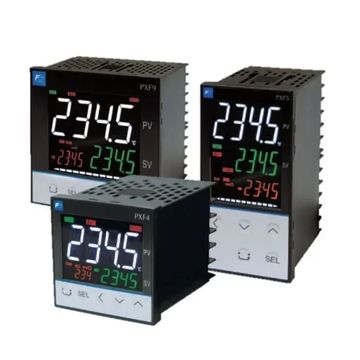

Fuji temperature controllers are key to optimal temperature control. Information from multiple controllers can be collectively displayed by using the communication function. Measurement fluctuations can be prevented – like when sudden changes in incoming signals to a level gauge of a water tank can be smoothed, when required. Ratio control is possible – for example, the flow rate of chlorine fed to tap water can be controlled at a constant level.
Inside a furnace, temperatures can be equalized – by treating the setting of controller No.1 as the input setting of other controllers the temperature within a tunnel furnace can be equalized.
Temperature patterns can be controlled – the setting can be changed with time according to the pattern selected. On standby, energy saving operations are possible when the setting is switched between 20°C (on standby) and 400°C (during operation) with an external command switch.
Control loop errors can be detected. In a loop that uses an AC power regulator (APR), judgment on issuance of a heater break alarm cannot be made by a current detector (CT). The controller type PXG and PXF detects an error of the loop based on the operation output and the width of temperature fluctuation
Controlling both heating and cooling is possible with a single controller – for example only one controller is required to keep the temperature of a cattle shed constant all year round, by cooling down the hot summer heat with a fan and warming up the cold winter air with a heater.
Achieved a processing speed of 50 ms which is 10 times faster than conventional models. Reading accuracy is also improved from ±0.5% to ±0.2%*.
*Comparison under 0–850°C range, with RTD. See the Data Sheet for details.
MVA LCD* which offers high contrast and wide viewing angle
Process value is displayed in white
*Minimal translucent type vertical alignment liquid crystal display
Simple watt-hour metering function: allows you to monitor energy consumption
Operating days alarm: tells you the appropriate time for maintenance work
36% smaller (than conventional models) and 58-mm depth shallow body helps downsize your facility
You can use any input among RTD, thermocouples, voltage, current, and mV. The set-up for input change is very easy, only requires parameter change. This allows reduction of maintenance parts.
In energy and utility segments, increasing efficiency and cutting down waste are some of the key challenges many …
Most of the energy consumption in Water and Waste Water Treatment Plant (WTP) is electric power consumption it is …
Fuji Electric offers a wide range of design and consultation services related to the development of solutions in all of the industry sectors we operate in. Each project requires specific inputs and deep expertise to create the best possible solutions